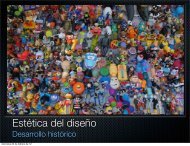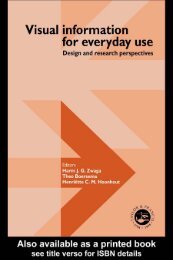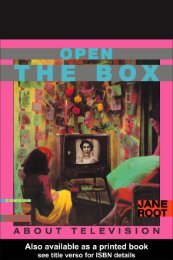Edited by Chris Jenks - carlosmoreno.info
Edited by Chris Jenks - carlosmoreno.info
Edited by Chris Jenks - carlosmoreno.info
Create successful ePaper yourself
Turn your PDF publications into a flip-book with our unique Google optimized e-Paper software.
AN INTRODUCTION<br />
The city, though traceable as a topic to the works of Weber, Simmel and<br />
the early Chicago School has nevertheless re-emerged as a fecund image<br />
and metaphor within the most contemporary of social theory.<br />
Paradoxically, however, as James Donald argues, although the city is a site<br />
of visibility, it now has to be imagined rather than seen. Urbanist discourse<br />
represents the space and population of the city so as to render it a<br />
governable object. The inhabitants of the city, and not just the flâneurs,<br />
have a different view: they see it through a prism of memory, desire and<br />
fantasy, re-enchanting the rationalist vision of the planners.<br />
In his chapter Donald explores how this modernist ambivalence has been<br />
played out in representations of the city in cinema and, to a lesser extent,<br />
in photography. The ‘city symphony’ films of the 1920s, like Ruttman’s<br />
Berlin: Symphony of a Great City and Vertov’s Man with a Movie Camera,<br />
all capture the rhythms of the modern metropolis in styles that recall either<br />
Simmel’s sociology or the poetry of Ezra Pound. Yet however seductive<br />
their documentary aesthetic, Donald argues, it is flawed <strong>by</strong> the same<br />
ambiguities as the modernist urbanism of Le Corbusier and the Bauhaus.<br />
In contrast to this, he suggests that the vulgar fictions of popular cinema<br />
tell us a different story of the city; the totalitarianism of Metropolis; the<br />
primitivism of King Kong; the postmodern pessimism of Blade Runner, the<br />
comic-book dystopia of Batman or Akira. It is these latter, impossible yet<br />
imaginable cities, buildable only in the film studio, that Donald elects as<br />
the main topic of his analysis.<br />
Having established a bow wave of anticipation for his writings on the<br />
interminable aporia of the postmodern, Dick Hebdige, in his chapter,<br />
reverses that flow and investigates a modernist starting point, or a pre-post-<br />
. His moment, preceding the deformation of the metanarrative of vision<br />
through depiction, is chosen from contemporary visual art. Specifically<br />
Hebdige provides an analysis of the strategies and purposes of Pop art, but<br />
particularly its youthful parentage in the hand-painted Pop art emanating<br />
from America between 1955–62. This category is constituted through a<br />
collection of painters and their work which predated and <strong>info</strong>rmed what we<br />
conventionally regard as ‘Pop’ art.<br />
The chapter explores a number of canvases and their critical reception<br />
but it is specifically organised around the unspecifically disorganised<br />
theme of confusion; that which Hebdige regards as a principled and<br />
rigorous necessity of any Pop critic. The confusions proliferate in his<br />
attempting to distinguish between the painterly aesthetic of the work in<br />
hand and the mechanistic and technological manifesto of the mainstream<br />
Pop that claimed the public’s attention through the 1960s. The chapter<br />
further attempts to unravel the confusion woven through the conflation of<br />
Pop with popular and mass symbolism.<br />
At another level Hebdige is opening our eyes to the birth and reception<br />
of genre, which he achieves <strong>by</strong> locating such artistic practice within its<br />
19






